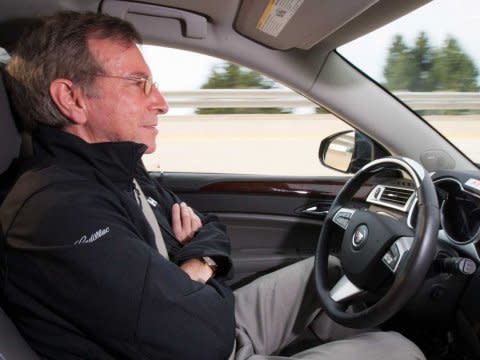GM — Not Google — Is Our Best Hope For A Self-Driving Car In The Near Future

Going by the promises of some automakers, you'd think all cars will be driving themselves in just a few years.
Nissan promises it will put an autonomous car on the market by 2020. Mercedes-Benz says the same thing.
GM, meanwhile, is taking pains not to promise the moon. By 2018, it says its Cadillac will offer Super Cruise, "capable of semi-automated driving" on the freeway and in bumper-to-bumper traffic.
Drivers won't be able to nap or read the paper while the car does all the work. According to GM: "Driver attention will be required."
That doesn't sound nearly as cool as Google's autonomous car, which took a blind man to Taco Bell all on its own. But it earned GM a Popular Mechanics Breakthrough Award, which recognizes "the innovators and products that have advanced the fields of technology, medicine, space exploration, automotive design, and more."
Why an award for the automaker that promises less than its competitors?
"Right now it appears GM is likely to be the first to market with a real-world vehicle," Popular Mechanics Editor-in-Chief Jim Meigs told Business Insider. "Super Cruise doesn't claim to offer fully autonomous operation, and the fact is, our legal and physical infrastructures aren't ready for that anyway."
Andrew Del Colle, who has written about Super Cruise for Popular Mechanics, agreed. "We feel that it is the first self-driving tech ready for public roads. And by allowing the driver to let go of the wheel for extended periods of time, it also represents a historic shift in the driver-car relationship and the first major step on the way to an autonomous future," he said in an email.
The technology for self-driving cars already exists, and the real questions now are how to make sure they are safe, and how to answer the legal and insurance-related questions they bring up.
If an autonomous car gets into an accident with one driven by a human, who is to blame? How do you assign fault to a computer program? Do you assume the human screwed up?
Karl Brauer, a senior analyst at Kelley Blue Book, said GM's approach is "realistic." There are tons of legislative and legal hurdles to putting autonomous cars on the market, he explained in an interview, and the learning curve is steep.
Super Cruise is a "definite stepping stone," he said, adding that the piecemeal approach may be a way for manufacturers "to learn how well these systems work" before going all in. That's why GM picked simple functions — highway and slow traffic driving — to start out.
Going into uncharted territory, where humans give control over to machine, using a stepping stone is a wise move.
See Also:
Tesla Is Working To Build A Driverless Car Running On 'Auto-Pilot' Within The Next 3 Years
DEAR AUTOMAKERS: It's Time To Stop Pushing Your Crazy Infotainment Systems
Elon Musk: I'll Build A Hyperloop Prototype If No One Else Does [VIDEO]
DEAR AUTOMAKERS: It's Time To Stop Pushing Your Crazy Infotainment Systems

 Yahoo News
Yahoo News 
